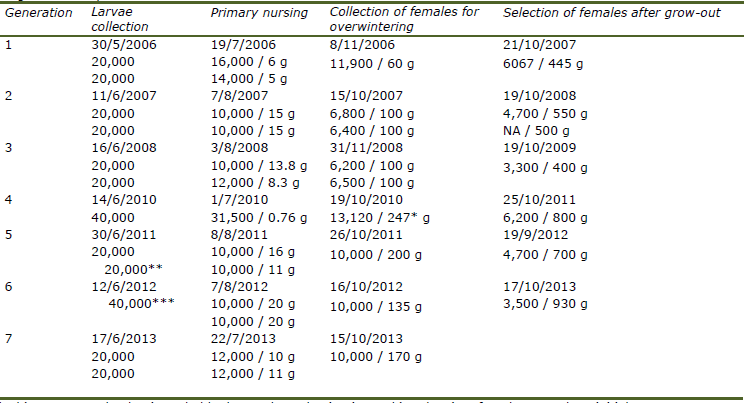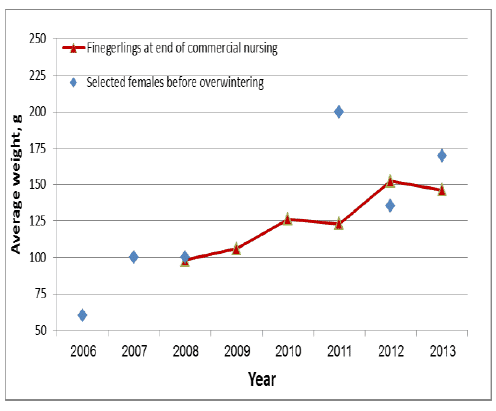The main reason for this procedure was the low number of offspring produced by the nearly all-male O. niloticus female x O. aureus s male cross. However, hatchery operators have shifted to producing the F2 derived from F1 hybrids obtained from the reciprocal cross (O. aureus x O. niloticus). This hybrid is much more fertile and sufficient numbers of F2 progeny are obtained on a commercial scale. These F2 fish undergo sex-reversal resulting in a high proportion of males for stocking (Rothbard et al., 1983; Mires et al. 1990; Wohlfarth, 1994). Over the years, local hybrid-derived tilapia strains were developed by subsequent within-stock crosses (F3, F4, etc.).
Selective breeding programs have proven very effective in increasing productivity in various aquacultured species (Gejdrem, 2005). Starting with GIFT (Genetically Improved Farmed Tilapia), Nile tilapia has been genetically improved in several breeding programs (Eknath et al., 1993, 2007; Eknath and Hulata, 2009; Ponzoni et al., 2005, 2011) and has continued with several off-shoots from the GIFT breeding program (Romana-Eguia et al., 2010; Thodesen et al., 2012), or independent ones carried out in Egypt (Khaw et al., 2009; Rezk et al., 2009) and elsewhere. A few breeding programs focusing on blue tilapia, O. aureus, have been reported (Thodesen et al., 2013; Zak et al., 2014). All these were large-scale, family-based breeding programs conducted at various research centers or by the private sector; most have been far too complicated and expensive to be conducted on-farm. However, many good, selectively-bred, tilapia lines have been produced on farms using mass selection for growth rate. Not all are well documented, but some have been described in detail (e.g., Doyle et al., 1991; Brzeski and Doyle, 1995; Basiao and Doyle, 1999; Hallerman, 2000). Farmers wishing to improve productivity of their own strain, like the stock developed at Kibbutz Reshafim, must use procedures that are within their financial and technical capabilities. The paper describes the breeding program implemented at the Reshafim Fish farm.
Materials and Methods
General spawning procedures: A simple selective breeding program was designed to improve growth rate by individual selection, following procedures described in Tave's (1995) FAO manual. In mass spawning of tilapia, asynchronous spawning is a major source of variation that may mask the genetic component of growth. To overcome this, larvae were collected from the mouths of females in a spawning pond on a single day.
The protocol followed was that in each generation, broodstock consisting of 3000 females and 1000 males was used. Spawning was carried out in 0.4-ha ponds. The youngest broodstock were used to produce the next generation of the breeding program. For every generation 40,000 larvae were collected in June and transferred to one or two nursing ponds. Six to ten weeks later (July/August), around 20,000 fingerlings were transferred to a secondary nursing pond. Two to three months later (October/November), the fish were harvested and sexed. Females only were transferred to an over-wintering facility, and subsequently grown in one or two ponds until fall (September/October) of the following year. In the subsequent spring, at 2 years of age, these females were added to the broodstock and mated with males selected from commercial ponds to produce the next generation of fry for selection. After completing collection of fry for the breeding program, the broodstock produced fry for supplying the production needs of the farm.
In 2007, small, young females selected in 2006 were added to the broodstock. Subsequently, the broodstock consisted of selected two-year old females, accounting for one-third to one-half of the females in the broodstock. Males were selected from the commercial grow-out populations, initially by gross phenotype, and later by size.
Selection procedures: The schedule of activities is presented in Table 1. The procedure for Generation 4 (2010) differed from all others in that the initial nursing phase was shorter, lasting only a few weeks. The fingerlings attained a weight of 0.76 g, and 75% of them were transferred to the secondary nursing.
In 2009, no selection was done on females, and instead males were selected. These males were used for breeding only in 2010. The 2008-selected females were used in both 2009 and 2010.
Two separate spawnings were performed in 2011 - one with males of the selected line, and the other with males of O. aureus. Fry were mixed when they could be counted without damaging them. This was done in an attempt to "infuse" O. aureus genes into the broodstock.
In 2012, collection of larvae from females' mouths failed, and small fry were seined from the two ponds and nursed separately. Shortly thereafter, when they could easily be counted, equal numbers were randomly taken from each batch, mixed together and transferred to secondary nursing.
Nursing of commercial fingerlings for the farm's needs was carried out in a set of three 5-ha ponds.
Results and Discussion
The protocol — dates, numbers, and average mean size of each group, is presented in Table 1. We have chosen two groups as the most suitable for comparison between generations: (1) the mean weight of selected females at stocking to the over-wintering facility and (2) the mean weight of offspring produced from selected females, again at stocking to the overwintering facility (Figure 1 & Table 2).
Mean weight of selected females at stocking to the overwintering facility increased from 60 g in the first generation of selection (2006) to 170 g in the eighth generation (2013). There was some variation from year to year as conditions were not fully controlled. An unexpected increase in the weight of selected females in generation 4 (2010) to 247 g (Table 1) was probably due to the reduction in stocking density after the very short initial nursing, compared to other generations. Hence this value was excluded from Figure 1.
Mean weight at stocking to the overwintering facility of commercial progeny produced from selected females increased from 98 g in 2008 (the first generation selected females were used) to around 150 g in 2012 and 2013. Since no control line was kept there is no way to estimate how much gain is due to genetic improvement. However, this increase does indicate successful on-farm mass implementation of the selection program. The mean weight of the commercial seed produced is affected by culture conditions in the ponds, especially density at harvest which depends, among other factors, on survival. It is possible that mortality of fingerlings during nursing that has occurred in Israeli fish farms, led to lower final densities that resulted in increased growth rate. The cause of mortality has not been identified and hence is referred to as "summer disease". The final density of commercial nursing was particularly low in 2012. The average harvest weight was high compared to the previous two years. In 2013, the number of fingerlings harvested was similar to that of 2010, and final average weight was only slightly lower than that of 2013.
Although not all of this gain is genetic, the fish farmers of Reshafim and other farmers, feel that the quality of fish for stocking the commercial grow-out ponds has improved due to this breeding program.
July 2014






